- Table of Contents
-
- H3C S9500 Series Routing Switches Installation Manual-(V2.03)
- 00-1Cover
- 01-Chapter1 Product Overview
- 02-Chapter2 Preparing for Installation
- 03-Chapter3 Installing the Switch
- 04-Chapter4 Commissioning the Switch
- 05-Chapter5 Troubleshooting and Maintaining the Switch
- 06-Appendix A Cable Management
- 07-Appendix B Engineering Labels for Cables
- 08-Appendix C Installation of Lightning Arrester for AC Power
- Related Documents
-
| Title | Size | Download |
|---|---|---|
| 01-Chapter1 Product Overview | 2 MB |
Chapter 1 Product Overview
1.1 Introduction
The S9500 Series Routing Switches (hereinafter referred to as the S9500 series) are developed by Hangzhou H3C Technologies Co., Ltd. (hereinafter referred to as H3C) for use on business-oriented enterprise networks, the distribution layer of large MANs, the core layer of small MANs, and the backbone of large enterprise networks and campus networks. They can serve as switching cores and convergence centers.
Currently, the S9500 series consist of the following models:
l S9505: This model provides a switching capacity of up to 600 Gbps. It allows for the concurrent wire-speed forwarding on 240 GE ports, 20 × 10GE ports, 240 FE electrical ports, or 100 FE optical ports.
l S9508: This model provides a switching capacity of up to 960 Gbps. It allows for the concurrent wire-speed forwarding on 384 GE ports, 32 × 10GE ports, 384 FE electrical ports, or 160 FE optical ports.
l S9508V: This model provides a switching capacity of up to 960 Gbps. It allow for the concurrent wire-speed forwarding on 384 GE ports, 32 × 10GE ports, 384 FE electrical ports, or 160 FE optical ports. This model adopts upright slots.
l S9512: This model provides a switching capacity of up to 1.44 Tbps. It allows for the concurrent wire-speed forwarding on 576 GE ports, 48 × 10GE ports, 576 FE electrical ports, or 240 FE optical ports.
& Note:
Unless otherwise specified in this document, the S9508V and the S9508 have the same configuration.
1.2 Physical Structure
The S9500 series use integrated chassis, which consists of a power area, board area, backplane, and fan area.
& Note:
l Two switching and routing processor units (SRPUs) can be installed on the S9500 series to support active-standby switchover.
l Two power supply units (PSUs) can be installed on the S9500 series to provide hot-standby 1+1 redundancy.
l The S9500 series support PoE and an external PoE power supply is optional.
l Boards, fan tray, and AC/DC PSUs are hot-swappable.
1.2.1 Chassis and Slots
I. S9505
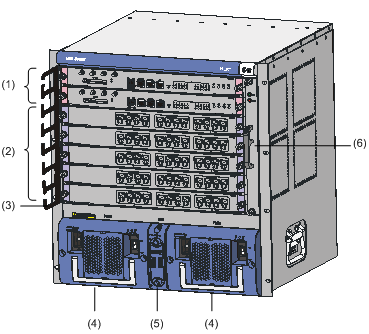
|
(2) LPU slots |
(3) Cable management bracket |
|
|
(4) PSUs |
(5) PoE power entry module |
(6) Fan tray |
Figure 1-1 Front view of the S9505
l The S9505 chassis provides seven slots in its board area: The top two accommodate SRPUs, which can operate in 1+1 redundancy mode; the remaining five accommodate LPUs/service boards.
l At the bottom of the chassis is the power area that contains one PoE entry module and two PSUs. The two PSUs are hot-swappable; they can operate in 1+1 redundancy mode. The switch supports both AC and DC power inputs. So you can select AC or DC PSUs as needed.
II. S9508
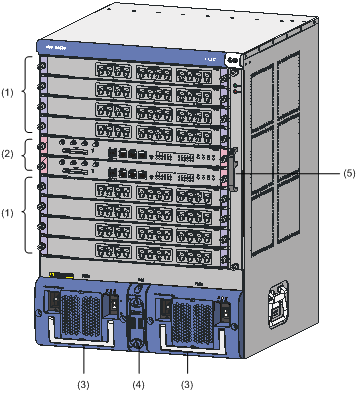
|
(1) LPU slots |
(2) SRPU slots |
(3) PSUs |
|
(4) PoE power entry module |
(5) Fan tray |
|
Figure 1-2 Front view of the S9508
l The S9508 chassis provides ten slots in its board area: The middle two accommodate SRPU modules; the remaining eight accommodate LPUs/service boards.
l At the bottom of the chassis is the power area that contains one PoE power entry module and two PSUs. The switch supports both AC and DC power inputs. So you can select AC or DC PSUs as needed.
l On the right of the chassis is the fan area that contains one vertical fan tray. The fans draw air in from the left and exhausts air from the right.
III. S9508V
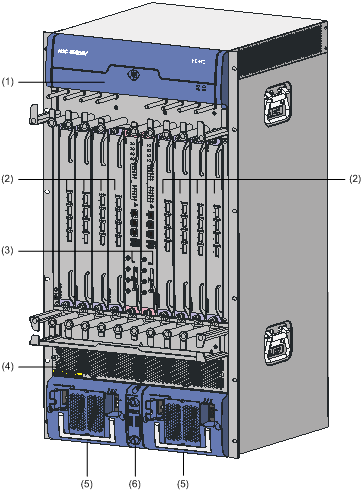
|
(1) Fan tray |
(2) LPU slots |
(3) SRPU slots |
|
(4) Air filter |
(5) PSUs |
(6) PoE power entry module |
Figure 1-3 Front view of the S9508V
l The S9508V chassis provides ten vertical slots in its board area: The middle two accommodate SRPU modules; the remaining eight accommodate LPU/service boards.
l At the bottom of the chassis is the power area that contains one PoE power entry module and two PSUs. The switch supports both AC and DC power inputs. So you can select AC or DC PSUs as needed.
l Above the power area is the air filter, which can be removed from the chassis in the case of replacement or regular cleaning.
l On the top of the chassis is the fan area that contains one horizontal fan tray. The fans draw air in from the bottom and exhaust air from the top.
IV. S9512
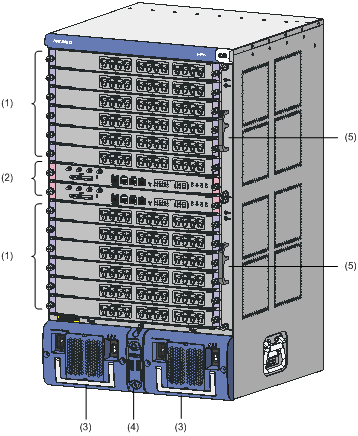
|
(1) LPU slots |
(2) SRPU slots |
(3) PSUs |
|
(4) PoE power entry module |
(5) Fan trays |
|
Figure 1-4 Front view of the S9512
l The S9512 chassis provides fourteen slots in its board area: The middle two accommodate SRPU modules and the remaining twelve accommodate LPUs/service boards.
l At the bottom of the chassis is the power area that contains one PoE entry module and two PSUs. The switch supports both AC and DC power inputs. So you can select AC or DC PSUs as needed.
l On the right of the chassis is the fan area that contains two vertical fan trays. The fans draw air in from the left and exhaust air from the right.
1.2.2 Backplane
The backplane of the S9500 series allows high-speed data exchange between SRPUs and LPUs, as well as the exchange of various management and control signals in the system.
I. Functions
The following are the main functions of the backplane:
l Providing communication channels for signal exchange between boards
l Supporting board hot-swapping
l Supporting board auto-discovery in slots
II. Structure
The S9500 series use a passive backplane, which provides multiple board slots, one or two fan interfaces, and two –48V power interfaces (one for PSUs and the other for PoE power entry module).
1.2.3 Power System
& Note:
l The S9500 series support both AC and DC power inputs. So you can choose AC or DC PSUs as needed.
l The S9500 series support 1+1 power supply redundancy.
l The PSUs of the S9500 series are hot-swappable.
The power system is at the bottom of the chassis. In the PSU slots, you can insert either two AC PSUs or two DC PSUs. The PSUs are cooled by the built-in fans, which draw air into the chassis from the front and exhaust air from the rear.
l AC PSU
Table 1-1 Specifications for AC PSUs
|
Item |
Specifications |
||
|
NEPS1200-A |
NEPS2000-A |
NEPS3500-A |
|
|
Model |
S9505 |
S9508/S9512 |
S9508/S9512 |
|
Rated voltage range |
100 to 240 VAC, 50 Hz or 60 Hz |
100 to 120 VAC, 60 Hz 200 to 240 VAC, 50 Hz |
100 to 240 VAC, 50 Hz or 60 Hz |
|
Input voltage range |
90 to 264 VAC, 50 Hz or 60 Hz |
90 to 264 VAC, 50 Hz or 60 Hz |
90 to 264 VAC, 50 Hz or 60 Hz |
|
Max input current |
15 A |
15 A |
Single 1800 W sub-PSU :15 A Two 1800W sub-PSUs: 30 A |
Table 1-2 Configuration and output power of AC PSUs
|
PSU |
Configuration |
Maximum output power |
|
NEPS1200-A |
1 × NEPS1200-A, no redundancy 2 × NEPS1200-A, 1+1 redundancy |
1200 W (90 V to 264 V) |
|
NEPS2000-A |
1 × NEPS2000-A, no redundancy 2 × NEPS2000-A, 1+1 redundancy |
1200 W (90 V to 160 V) 2000 W (160 V to 264 V) |
|
NEPS3500-A |
1 × NEPS3500-A enclosure + 1 × sub-PSU, no redundancy 1 × NEPS3500-A enclosure + 2 × sub-PSU, 1+1 redundancy |
1200 W (90 V to 180 V) 1800 W (180 V to 264 V) |
|
1 × NEPS3500-A enclosure + 2 × sub-PSU, no redundancy 2 × NEPS3500-A enclosure + 3 × sub-PSU, 2+1 redundancy 2 × NEPS3500-A enclosure + 4 × sub-PSU, 2+2 redundancy backup |
2400 W (90 V to 180 V) 3500 W (180 V to 264 V) |
|
|
2 × NEPS3500-A enclosure + 3 × sub-PSU, no redundancy 2 × NEPS3500-A enclosure + 4 × sub-PSU, 3+1 redundancy |
3500 W (90 V to 180 V) |
l DC PSU
Table 1-3 Specifications for DC PSUs
|
Item |
Specifications |
||
|
NEPS1200-D |
NEPS2000-D |
NEPS3500-D |
|
|
Model |
S9505 |
S9508/S9512 |
S9508/S9512 |
|
Rated voltage range |
–48 to –60 VDC |
–48 to –60 VDC |
–48 to –60 VDC |
|
Input voltage range |
–36 to –72 VDC |
–36 to –72 VDC |
–36 to –72 VDC |
|
Max input current |
25 A |
42 A |
75 A |
|
Max output power |
1,200 W |
2,000 W |
3,500 W |
1.2.4 PoE Power Supply
The S9500 series support power over Ethernet (PoE). With this feature, an S9500 switch equipped with an external PoE power supply and PoE-capable LPUs can deliver –48 VDC to its remotely powered devices (PDs), such as IP phones, wireless LAN (WLAN) access points (APs) and network cameras, through Ethernet cables.
Currently, among the LPUs of the S9500 series, only GV48 is PoE capable.
l The S9500 series can supply power to remote PDs through Ethernet electrical ports on the LPUs. Each LPU can simultaneously supply power to up to 48 PDs with the maximum distance of 100 m (328.1 feet).
l Each Ethernet port can deliver up to 15.4 W to its PD.
l The S9500 series determine whether to deliver power to a newly detected PD according to the following condition: If the remaining PoE power of the switch is greater than what is required by a newly detected PD, the switch supplies power to it. Otherwise, the switch does not supply power to it.
I. PoE power entry module
The PoE-supported S9505/S9508/S9508V/S9512 switch chassis has a PoE power entry module between the two PSUs. You can connect this PoE power entry module to an external PoE power supply PSE4500-A.
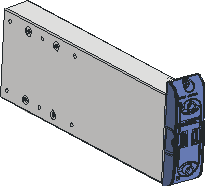
Figure 1-5 PoE power entry module
II. External PoE power supply
The S9505/S9508/S9508V/S9512 uses the PSE4500-A power system as an external PoE power supply. Figure 1-6 shows the PSE4500-A front panel.
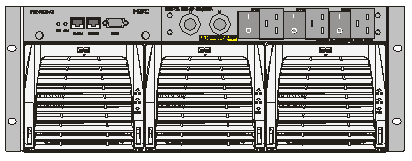
Figure 1-6 PSE4500-A front panel
Table 1-4 describes typical equipment configurations and specifications of PSE4500-A.
Table 1-4 Typical equipment configurations and specifications of PSE4500-A
|
Item |
Specifications |
|
Physical dimensions (H ´ W ´ D) |
175 × 482.6 × 320.5 mm (6.89 ´ 19.00 ´ 12.62 in.) |
|
System controller |
One |
|
Rectifiers (NP2500UAC) |
Two NP2500UACs (required) + one redundant NP2500UAC (optional); NP2500UAC is hot-swappable |
|
AC accessories |
Three AC inputs and switches Three AC voltage detection circuits Input voltage range: 90 to 264 VAC |
|
DC accessories |
A single DC output, with a max output power of 4500 W (220 V)/2400 W (110 V) |
The external PoE power system has the monitoring function. It provides one RS232 and two RS485 monitoring interfaces. The external PoE power supply can display alarm information through the ALM LED. The system can learn the running information of the rectifiers by connecting a monitoring port to the SRPU. You can use cables to connect the monitoring ports from the front or the rear of the external PoE power supply.
& Note:
The external PoE power system for the S9500 series only support RS485 monitoring ports.
Table 1-5 LEDs of external PoE power system
|
LED |
Label |
Color |
Normal state |
Abnormal state |
Abnormal reason |
|
Input power LED |
AC |
Green |
ON |
OFF |
Loss of AC input power, or blown fuse |
|
Output power LED |
DC |
Green |
ON |
OFF |
No DC output from PSU |
|
Fault LED |
Fault |
Red |
OFF |
ON |
Irreversible fault occurred in PSU |
|
Running status LED |
RUN |
Green |
ON |
OFF |
PSU shutdown or PSU running trouble |
|
Alarm LED |
ALM |
Red |
OFF |
ON |
Loss of AC input power, under-voltage or over-voltage input, over-voltage output, output short-circuit, or PSU fault |
1.2.5 Fan Tray
l The S9505 uses one 25 W fan tray, which contains four 120 × 120 × 25.4 mm (4.7 × 4.7 × 1.0 in.) DC fan units.
l The S9508 uses one 35 W fan tray, which contains six 120 × 120 × 25.4 mm (4.7 × 4.7 × 1.0 in.) DC fan units.
l The S9508V uses one 70 W fan tray, which contains six 120 × 120 × 38 mm (4.7 × 4.7 × 1.5 in.) DC fan units.
l The S9512 uses two 25 W fan trays, each of which contains four 120 × 120 × 25.4 mm (4.7 × 4.7 × 1.0 in.) DC fan units.
The fans of the S9505/S9508/S9508V/S9512 operate at –48 VDC supplied from the backplane.
![]()
Figure 1-7 Fan tray panel of the S9505/S9508/S9512

Figure 1-8 Fan tray panel of the S9508V
Table 1-6 LEDs on fan tray panel
|
LED |
Color |
Status |
Meaning |
|
RUN |
Green |
OFF |
The fan tray is faulty. |
|
ON |
The fan tray is operating normally. |
||
|
ALM |
Red |
OFF |
The fan tray is operating normally. |
|
ON |
The fan tray is faulty. |
1.3 Switching and Routing Processing Unit
SRPUs serve as the core of the S9500 series. They mainly have the following functions:
l Route calculation and forwarding table maintenance.
l Integrating crossbar switching fabric to accomplish service exchange between different boards.
l Providing system configuration and monitoring functions, which allows the system to monitor other boards and upgrade/reset service board software.
The following table lists the SRPUs applicable to the S9500 series.
Table 1-7 SRPUs applicable to the S9500 series
|
SRPU |
S9505 |
S9508 |
S9508V |
S9512 |
|
|
LSB1SRP1N4 |
|
|
|
ü |
|
|
LSB1SRP1N5 |
|
ü |
ü |
|
|
|
LSB1SRP1N6 |
ü |
|
|
|
|
|
LSB1SRP1N7 |
ü |
ü |
ü |
ü |
|
|
LSB1SRP2N4 |
|
|
|
ü |
|
|
LSB1SRP2N5 |
|
ü |
ü |
|
|
|
LSB1SRP2N6 |
ü |
|
|
|
|
|
LSB1SRP2N7 |
ü |
ü |
ü |
ü |
|
|
LSB2SRP2N4 |
|
|
|
ü |
|
|
LSB2SRP2N5 |
|
ü |
ü |
|
|
|
LSB2SRP2N6 |
ü |
|
|
|
|
|
LSB2SRP2N7 |
ü |
ü |
ü |
ü |
|
& Note:
The tick ü indicates that the SRPU is applicable to the switch. SRP2N’s forwarding capacity is twice the SRP1N’s.
1.4 Line Processing Unit
The following LPUs are available:
|
LPU |
Suffix |
User interface |
|
LSB1FP20 |
B0, CA0 |
20 × 100 Mbps SFP/LC optical ports |
|
LSB1F32G |
B0, CA0 |
4 × 1000 Mbps SFP/LC optical ports and 32 × auto-sensing 10/100 Mbps RJ-45 ports |
|
LSB1FT48 |
B0 |
48 × auto-sensing 10/100 Mbps RJ-45 electrical ports |
|
LSB2FT48 |
CA0 |
48 × auto-sensing 10/100 Mbps electrical ports |
|
LSB1GP12 |
B0, CA0, DB0 |
12 × 1000 Mbps SFP/LC optical ports |
|
LSB1GP24 |
B0, CA0, CB0, DB0, DC0 |
24 × 1000 Mbps SFP/LC optical ports |
|
LSB2GP24 |
DB0, DC0 |
24 × 1000 Mbps SFP/LC optical ports |
|
LSB1GP48 |
DB0 |
48 × 1000 Mbps SFP/LC optical ports (1:4 convergence) |
|
LSB1GP48L |
DB0 |
48 × 1000 Mbps SFP/LC optical ports (wire-speed) |
|
LSB1GV48 |
DB0 |
48 × auto-sensing 10/100/1000 Mbps RJ-45 electrical ports (PoE-capable) |
|
LSB2GV48 |
DB0 |
48 × auto-sensing 10/100/1000 Mbps RJ-45 electrical ports (PoE-capable) |
|
LSB1GT24 |
B0, CA0, DB0 |
24 × auto-sensing 10/100/1000 Mbps RJ-45 electrical ports |
|
LSB2GT24 |
DB0 |
24 × auto-sensing 10/100/1000 Mbps RJ-45 electrical ports |
|
LSB1GT48L |
DB0 |
48 × auto-sensing 10/100/1000 Mbps RJ-45 electrical ports (wire-speed) |
|
LSB1P4G8 |
CA0 |
8 × 1000 Mbps SFP/LC optical ports and 4 × OC-3c SFP/LC POS optical ports |
|
LSB1GT8P |
CA0 |
4 × 1000 Mbps SFP/LC optical ports and 8 × auto-sensing 10/100/1000 Mbps RJ-45 ports |
|
LSB1XP2 |
B0, CA0, CB0, DB0, DC0 |
2 × 10GBase-R XFP/LC/10GBase-W XFP/LC optical ports |
|
LSB1XP4 |
B0, CA0, DB0 |
4 × 10GBase-R XFP/LC/10GBase-W XFP/LC optical ports (1:2 convergence) |
|
LSB1XP4L |
DB0 |
4 × 10GBase-R XFP/LC/10GBase-W XFP/LC optical ports (wire-speed) |
|
LSB1XP4T |
DB0 |
4 × 10GBase-R XFP/LC/10GBase-W XFP/LC optical ports |
|
LSB1XK1 |
B0, CA0, DB0 |
1 × 10GBase-R XENPAK/SC port |
|
LSB1SP4 |
CA0 |
4 × OC-48c SFP/LC POS optical ports |
|
LSB1UP1 |
CA0 |
1 × OC-192c XFP/LC POS optical port |
|
LSB1VP2 |
CA0 |
2 × OC-192c XFP/LC RPR optical ports |
|
LSB1RSP2 |
CA0 |
2 × OC-48c SFP/LC RPR optical ports |
& Note:
The first column and the second column in the above table form an LPU model, for example, LSB1XP2B0.
1.5 Service Board
Each kind of service board is specially designed for high-speed processing of a certain service and has partial or no functions of LPU.
Currently, the following service boards are available:
l LSB1NATB0: for NAT service, no service port
l LSB1VPNB0: for VPLS service, no service port
l LSB1NAMB0: for NAM service, no service port
& Note:
For detailed specifications for the SRPUs, LPUs, and service boards, visit the website at www. h3c.com.
1.6 System Specifications
The following table summarizes the physical specifications of the S9500 series.
Table 1-9 Technical specifications of the S9500 series
|
Item |
S9505 |
S9508 |
S9508V |
S9512 |
|
Dimensions (H × W × D) |
486 × 436 × 450 mm (19.1 × 17.2 × 17.7 in.) |
619 × 436 × 450 mm (24.4 × 17.2 × 17.7 in.) |
888 × 436 × 450 mm (35 × 17.2 × 17.7 in.) |
753 × 436 × 450 mm (29.6 × 17.2 × 17.7 in.) |
|
Weight (full load) |
£ 65 kg (143 lb) |
£ 80 kg (176 lb) |
£ 90 kg (198.4 lb) |
£ 100 kg (220 lb) |
|
Max power consumption |
1,200 W |
2,000 W |
2,000 W |
2,000 W/3,500 W |
|
Overall switching capacity |
SRP1N6: 300 Gbps SRP2N6: 600 Gbps |
SRP1N5: 480 Gbps SRP2N5: 960 Gbps |
SRP1N5: 480 Gbps SRP2N5: 960 Gbps |
SRP1N4: 720 Gbps SRP2N4: 1.44 Tbps |
|
Number of VLANs |
4 K |
|||
|
Forwarding table entries |
128 K/256 K/512 K |
|||
|
Number of SRPU slots |
2 |
2 |
2 |
2 |
|
SRPU type |
LSB1SRP1N6 LSB1SRP1N7 LSB1SRP2N6 LSB1SRP2N7 |
LSB1SRP1N5 LSB1SRP1N7 LSB1SRP2N5 LSB1SRP2N7 |
LSB1SRP1N5 LSB1SRP1N7 LSB1SRP2N5 LSB1SRP2N7 |
LSB1SRP1N4 LSB1SRP1N7 LSB1SRP2N4 LSB1SRP2N7 |
|
Number of LPU slots |
5 |
8 |
8 |
12 |
|
User interface |
l 10/100/1000BASE-TX RJ45 l 10/100BASE-TX RJ45 l 1000BASE-X-SFP/LC l 100BASE-FX SFP/LC l 10GBASE-R XENPAK/SC l 10GBASE-R/W XFP/LC l OC-3c SFP/LC POS l OC-48c SFP/LC POS l OC-192c SFP/LC POS l OC-48c SFP/LC RPR l OC-192c SFP/LC RPR |
|||
|
Operating temperature |
0°C to 45°C (32°F to 113°F) |
|||
|
Operating humidity (noncondensing) |
10% to 90% |
|||
|
Storage temperature |
–40°C to 70°C (–40°F to 158°F) |
|||
|
Storage humidity |
5% to 95% |
|||

